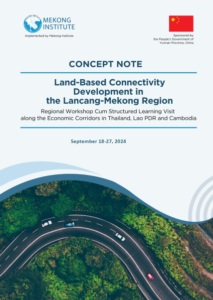Since 1998, the Greater Mekong Subregion has been using economic corridors to promote economic growth and development that goes beyond the impact of a road or highway project. In recent years, the establishment of Economic Corridors has resulted in an enhanced level of connectivity within the Greater Mekong Sub-region (GMS) and beyond to Lancang-Mekong region.
According to Asian Development Bank (ADB), an economic corridor is much more complex than a mere road connecting two cities. It involves not only the development of infrastructure but also the crafting of laws and regulations that make it easier to do business, access markets, and conduct other activities that support trade and development in a comprehensive manner. This includes factories, tourism, trade, environmental protection activities and other aspects of the economy and social development of an area. Economic corridors are an integrated system of roads, rails, and ports that connect GMS countries. They link centers of production, including manufacturing hubs, industrial clusters, and economic zones, as well as centers of demand, such as capitals and major cities. They act as gateways to the subregion for regional and international trade.
Economic corridors bring a wide range of benefits, far beyond what any single project can deliver. There are three main economic corridors in the Greater Mekong Subregion (GMS): the (i) North-South Economic Corridor (NSEC); (ii) East-West Economic Corridor (EWEC); and Southern Economic Corridor (SEC). Plans are underway to expand these corridors, and strengthen links between GMS nations’ capital cities.
The NSEC R3a and R3b are particularly significant as they serve as crucial pathways linking China to ASEAN countries. The infrastructure of these NSECs comprises all-weather roads that span from Kunming to Bangkok through Myanmar (R3b) and via Lao PDR and the region of Thailand (R3a). Additionally, the land connectivity systems are being further improved through initiatives like the construction of the fourth international bridge across the Mekong River, connecting Houayxay and Chiang Khong on R3a. Moreover, road improvement projects funded by Thailand and China contribute to enhancing the connectivity between GMS countries and the rest of ASEAN members through the ASEAN highways.
The EWEC links important commercial areas of Mawlamyine-Myawaddy in Myanmar; Mae Sot-Phitsanulok-Khon Kaen-Kalasin-Mukdahan in Thailand; Savannakhet-Dansavanh in Lao PDR; and Lao Bao-Hue-Dong Ha-Da Nang in Vietnam. From the Da Nang pier, products can be transferred via cargo ships to arrive at Hanoi, Vietnam and Southern China. In the eastern side, from Khon Kaen, the EWEC will be interconnected with NSEC and further reach to inner part of P.R. China through the new and potential Thailand-Lao-China railway. The railway will establish a connection between China and Singapore, fostering new linkages between the Lancang-Mekong (LM) countries and global markets.
The SEC is a vital passageway linking Cambodia with six provinces in Thailand including Bangkok, four regions in Vietnam including Ho Chi Minh City, and six provinces in Lao PDR. It also reaches to Dawei in Myanmar. It covers the development of the following subcorridors:
- The Central Subcorridor: Bangkok-Phnom Penh-Ho Chi Minh City-Vung Tau;
- The Northern Subcorridor: Bangkok-Siem Reap-Stung Treng-Rattanakiri-O Yadov-Pleiku-Quy Nhon;
- The Southern Coastal Subcorridor: Bangkok-Trat-Koh Kong-Kampot-Ha Tien-Ca Mau City-Nam Can; and
- The Intercorridor Link: Sihanoukville-Phnom Penh-Kratie-Stung Treng-Dong Kralor (Tra Pang Kriel)-Pakse-Savannakhet, which links the three SEC subcorridors with the East-West Economic Corridor.
However, there are numerous obstacles that must be overcome. These include the fluctuating costs of transportation due to variations in transport and logistics capabilities, as well as the challenges posed by transloading freight between different rail track gauges. Additionally, there is a need for well-developed infrastructure and logistical services that connect train stations with other modes of transportation, production centers, and consumption hubs in LM countries. To fully capitalize on the advantages of land-based connectivity projects and foster trade and investment in the region, the importance of a comprehensive multi-modal transport system cannot be overstated. Achieving this requires strong coordination among stakeholders in GMS countries, including rail, road, port, and logistics service providers. By aligning plans and programs, these entities can ensure a smooth flow of goods and services, reducing both cost and time involved in the process.
Consequently, the project aims to establish a platform for stakeholders to exchange information with the goal of harmonizing operational procedures and border-crossing formalities through an effective coordination mechanism. The project will provide an opportunity for on-site assessments and interactions with key stakeholders in Thailand, Laos, and China, along with the EWEC and SEC to offer practical recommendations for harmonizing operational procedures, border crossing formalities, and facilities to enhance intra-regional trade. Ultimately, this will leverage the land connectivity infrastructure to accommodate and amplify the impact of economic activities in the GMS economic corridors.
The primary goal is to present a chance for the Lancang-Mekong (LM) countries to take advantage of improved land connectivity and transform it into economic corridors in the GMS. The project has the following main objectives:
- Identify and explore new cooperation needs and opportunities related to land-based connectivity in the GMS, with a particular emphasis on linkages of NSEC, EWEC and SEC.
- Assist participants in generating ideas for cooperation that can effectively leverage the emerging opportunities provided by land-based connectivity in the GMS.
- Acquire information regarding cross-border formalities and procedures, aiming to simplify and expedite border inspection processes (customs, sanitary, and phyto-sanitary) and improve cross-border facilities.
- Develop recommendations for harmonizing operational procedures and border crossing formalities through an efficient coordination mechanism.
The project target group will include mid-level officials from trade, industry, transport and logistics, and economic zone development-related organizations from P.R. China, Cambodia, Lao PDR, Myanmar, Viet Nam, and Thailand.
The ten-day event will be comprised of:
- a one-day workshop – Introductory Workshop on Day 2,
- a 7-day of Structured Learning Visit along the East-West Economic Corridor (EWEC) and the Southern Economic Corridor (SEC) on Days 3-9, and
- a one-day workshop – Synthesis and Evaluation Workshop on Day 10 to share learning obtained from the trip.



